10 STEPS FOR DESIGNING A BEDROOM | An Architect Explains
We spend a third of our lives sleeping. Functionally, every bedroom including the master, those of each family member and guest rooms should promote the restful and restorative sleep that is vital to good health. But unlike the shared spaces of a home, bedrooms can reflect the individual tastes and needs of one or two people, and allow a personalised look to be created.
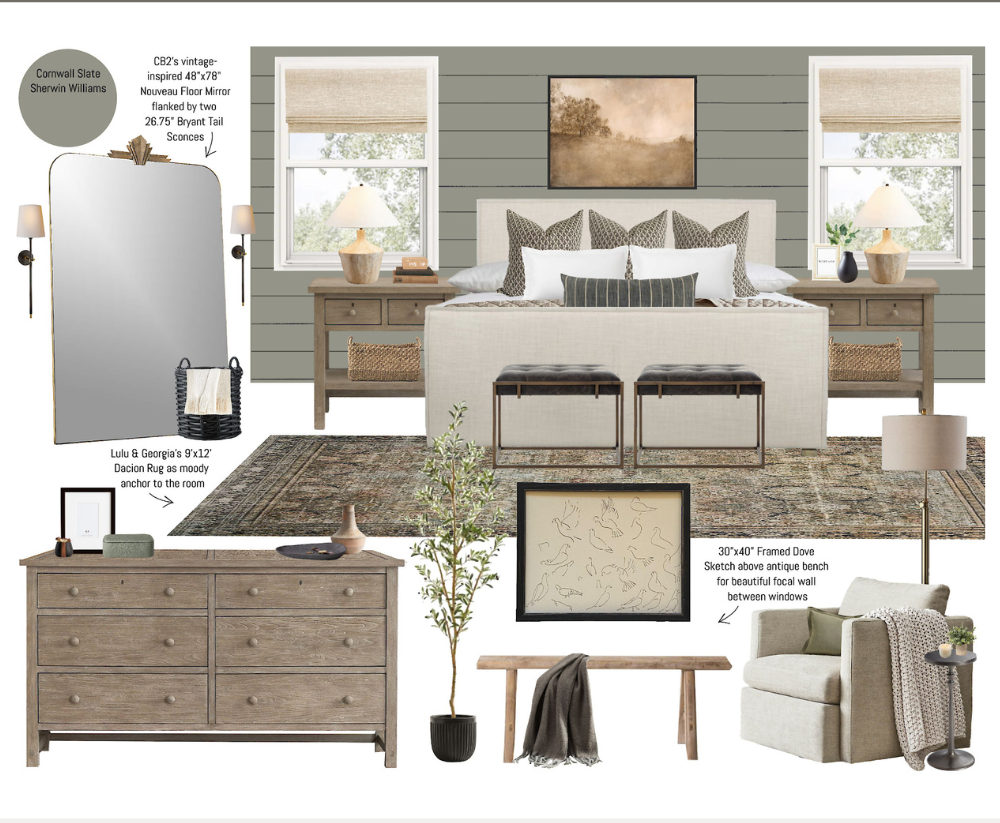
WHERE DO YOU START WHEN DESIGNING A BEDROOM?
It can be tricky to know where to start when designing a bedroom. An easy starting point would be to create a mood board. Get on Pinterest or flick through magazines and start collecting bedroom designs you like. You’ll soon start to see clear themes come through – the same colors, styles and patterns and you can start visualizing how you would like your room to end up looking.
It’s not easy, so as an Architect, I have given an easy step-by-step guide on how to decorate a bedroom If you follow these steps you can have a bedroom that that looks beautiful and suits your style but is a practical space too.
Step 1: Know your measurements
Step 2: Invest in practical bedroom furniture pieces
Step 3: Plan the best bedroom layout
Step 4: Choose the ideal bed
Step 5: Buy good bedding
Step 6: Pick the right drapes
Step 7: Invest in artificial lighting in the bedroom
Step 8: Choose the right colours for the bedroom
Step 9: Choose the right flooring in the bedroom
Step 10: Add art and wall accessories
1. KNOW YOUR MEASUREMENTS
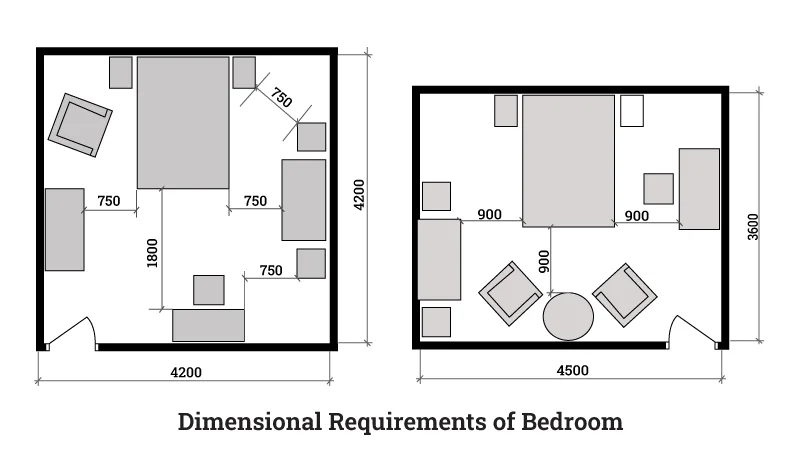
Measure the bedroom: The first thing you need to do is to – measure the bedroom and draw a sketch. You’ll have to pay special attention to walls with windows, doors, niches or alcoves. Make sure you measure the openings sizes too. Remember to take this sketch with you while shopping. It’ll prevent you from ordering incorrect size furniture or rugs or window curtains.
The size of a bedroom is crucial: The dimensions of the bedroom, particularly if it is small, will also influence choices such as decor, flooring and window treatments. Small bedrooms should allow passage through the space as well as fit the bedroom furniture. Conversely, if the bedroom is large, the furniture should be proportional to the space.
2. INVEST IN PRACTICAL BEDROOM FURNITURE
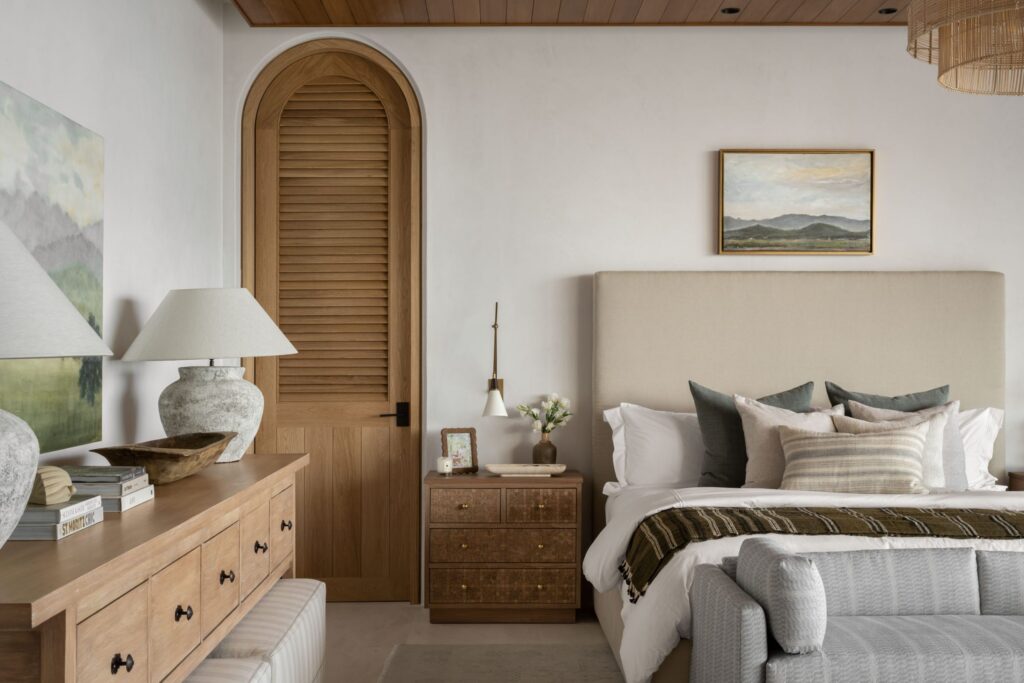
The main furniture pieces are a bed and a wardrobe: The main furniture that you will need in a bedroom are a comfortable sized bed and a place to store your clothes like a dresser or wardrobe
Any additional furniture: that you choose depends on the size of the room and your requirements. Some of the commonly used furniture pieces, if space allows, include:
- Two-night tables on either side of the bed. Nightstands should be proportioned to the room, and can provide the level of storage you need. If they’re only to function as a place for a lamp, and bedside reading, they can be finer in design while versions with drawers boost stash space.
- Possibly a small desk or a table 1 ft 6 in (45 cm) × 3 ft 0 in (90 cm)
- For larger bedrooms, an armchair or seating area, for example, in a bay window, is a welcome addition, making the room a peaceful refuge, and it can be zoned with an area rug. If there is not enough space, consider a bench for the end of the bed, which may incorporate storage
- Dressing table.
- A TV console if your screen is not to be wall mounted.
- One storage unit with drawers 2 ft 6 in (75 cm) × 1 ft 10 in (55 cm). A chest of drawers or dresser provides space for folded items in rooms where it’s not part of the closet. In a small room, go for tall vertical drawer storage to avoid filling the floor area.
- One Crib (Optional): 2 ft 4 in (70 cm) x 1 ft 5 (45 cm)
Fitted units or free standing units: The first consideration in choosing bedroom furniture is whether to go for fitted units or freestanding units. The choice will partly be dictated by the shape of your bedroom: awkwardly shaped rooms (often the case in period properties) will benefit from a bespoke fitted solution whereas regular spaces will work best with well-chosen furniture sets or an eclectic mix of bedside tables, bedroom storage units and a freestanding wardrobe. The advantage with freestanding options is that they can be considerably cheaper than fitted units and can be replaced every few years if you like to switch up your bedroom design.
Multi-functional Furniture: When choosing your bedroom furniture, pick pieces that double up as bedroom storage. For example a chest at the foot of the bed can store extra bedding, cushions and also serve as a seat
3. PLAN THE BEST BEDROOM LAYOUT
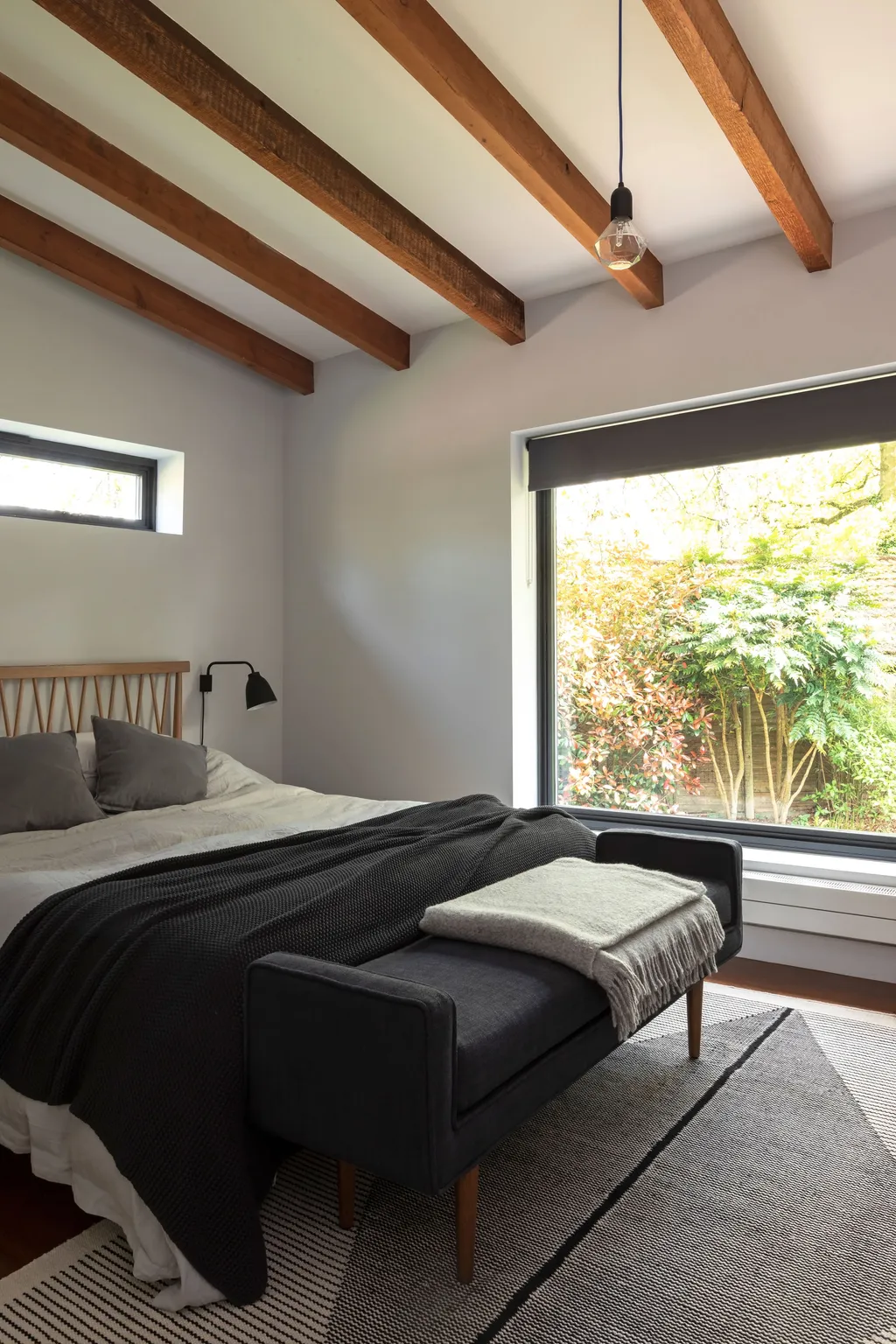
To design a bedroom, have in mind the room’s size, natural daylight, orientation, architectural features and so on, considering the potential benefits they bring as well as any issues they raise for which you will need to find solutions. If your bedroom has an en-suite, the layout should allow the two spaces to flow seamlessly into each other, bringing them together.
Draw the layout graph paper: Deciding on the layout of your bedroom furniture is a vital step in bedroom design. You may have little flexibility, but it’s worth drawing a layout on graph paper. Make a scale plan on graph paper the traditional way, or with an online planner. And start with the position of your bed because it is the largest and most important feature of the room, and then organize all other furniture around it.
Position of the bed: Placing the bed opposite the door as you enter the room will make it a focal point as soon as you walk into the room, but consider also allowing a view from it if the window offers a good one. However, in most bedrooms, the choice of position will be limited because of fixed features, such as windows and the door, which the bed should not block. Larger bedrooms will allow for more creativity, and you may want to position the bed in the center of the room. In small bedrooms, consider moving the bed into a corner to create adequate circulation space all round.
Adequate circulation space: Think about furniture position and circulation, and ensure there will be adequate space to move around. Make sure there is space for nightstands on either side of a bed for two and access to the bed from both sides and the end. This is the point at which you may need to edit down furniture choices aside from the essentials in a small bedroom.
Size of the bedroom: If you are pushed for space, then you might like to avoid freestanding furniture, like chests of drawers and wardrobes when planning your layout, in favour of bespoke in-built joinery. This might come in the form of shelving recessed into walls, under beds, or even incorporating hidden drawers within bunk beds. Even if you have a larger space with which to work, try not to clutter it unnecessarily. Instead, choose a few key pieces which work well in the space, complementing your chosen aesthetic and color palette.
Furniture choices: If you don’t have a separate closet for storage of clothes and shoes, you have to consider how much room you can spare for clothes storage. Bedroom storage options should be easy on the eye as well as functional. Consider mixing and matching your bedroom storage, especially if you have a lot of stuff that needs sorting and tidying – and sufficient space for a variety of storage units. You can also choose a bedroom storage set, matching your bedside cabinets to your wardrobe and bed frame, and adding a bedroom storage chest for maximum storage options. Also on your wish list might be a dressing table, a bench for the foot of the bed, armchairs to create a seating area, a TV console, and other smaller bedroom storage ideas. If a dressing table, reading area or desk is to be incorporated into the space, make sure it is placed near to natural light, ideally in front of a window.
4. CHOOSE THE IDEAL BED FOR YOUR BEDROOM
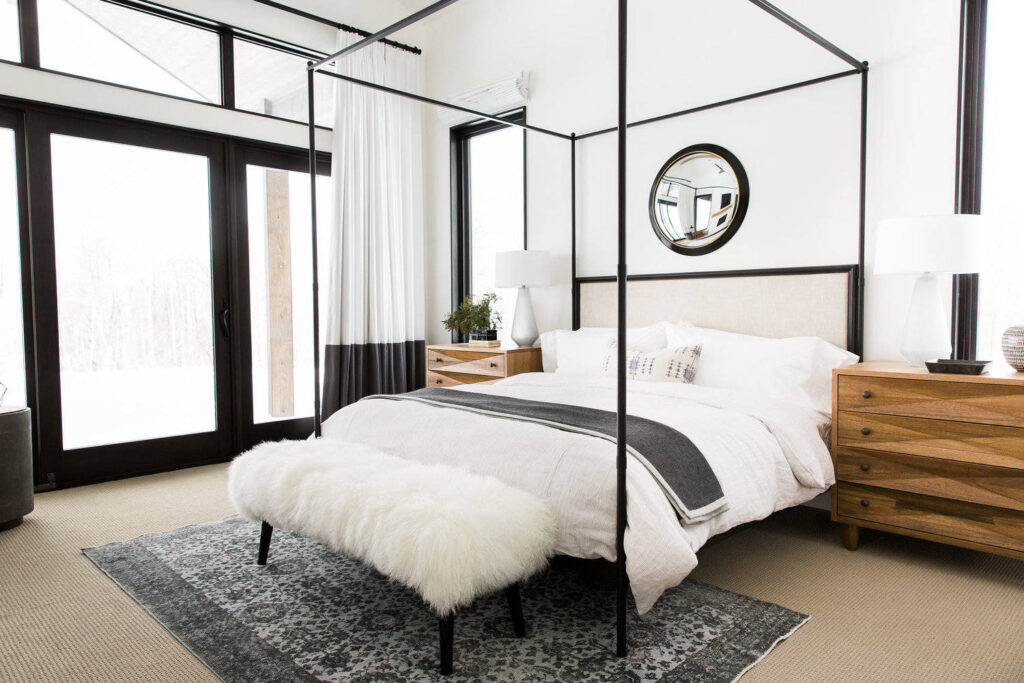
Carefully considered bed ideas will have an impact, too – the design, bulk, width and height of the bed will all impact your bedroom’s layout. The bed is the centerpiece when you are deciding how to design a bedroom and should be sized to its occupants as well as the room.
Bed size: Ideally, the bed should be 4 to 6 inches (10 to 15cm) longer than the height of the tallest sleeper and a couple should each be able to lie with hands behind their heads and elbows out without making contact.
Bed style: It should complement your overall scheme but can be used to dictate it, too. For example, if your preference is for a streamlined, minimalist look with a Scandi edge, go for a simple, white-washed wooden frame; if you want to add a feeling of luxury or an injection of pattern or color, a bed with an upholstered, padded headboard will be perfect.
Bed storage: For example, are you short on bedroom storage and would benefit from a divan with built-in drawers, or a bed that lifts up to reveal hidden storage in the base, or a bed with a storage headboard? Do you really need a king-sized bed frame, or could you save space with double bed instead?
Bed frame: Pick a bed frame that best suits your needs. Frame beds in metal or wood are the best complement to the bedroom, while upholstered beds are a stylish modern choice with soft tactility. In a small room, the clean lines of a modern bed design can maximize space – avoid ornate or heavy frames that will be visually or physically imposing. You can draw attention to a room with good height with a poster or canopy bed.
5. BUY THE BEST BEDDING
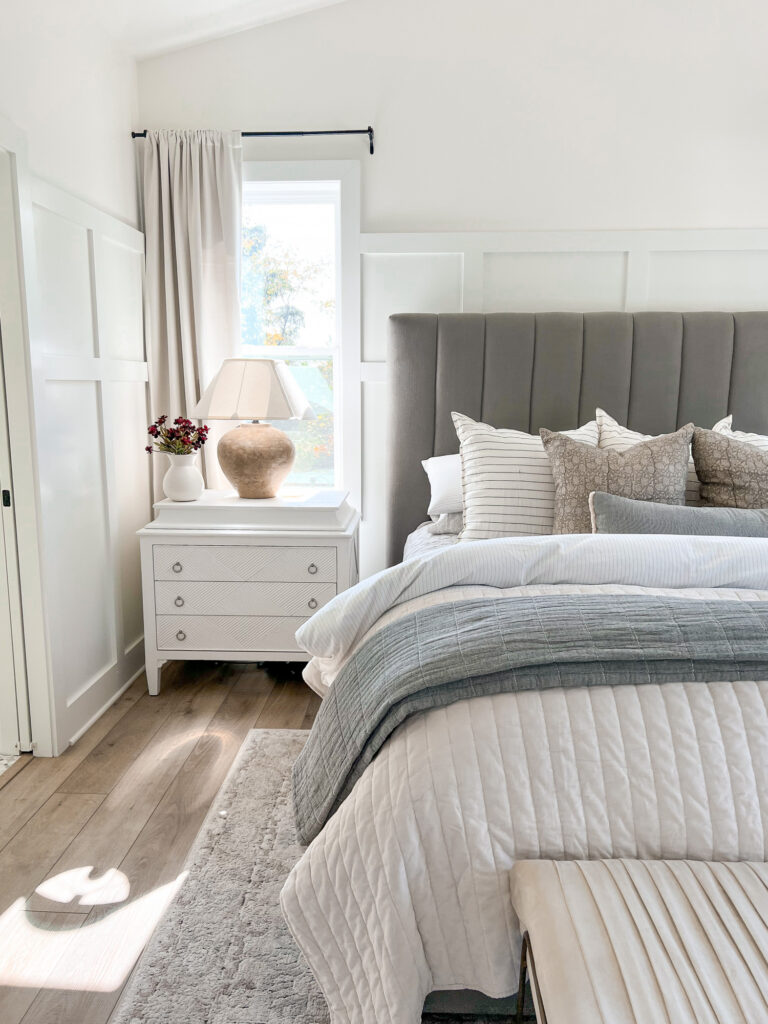
Choose the right mattress and pillows: Never underestimate the incredible difference the right mattress, pillow, super light duvet and super comfy topper will make. It can transform how comfortable we feel, eradicate neck and back pain, alleviate allergies, improve how well we sleep and as a result, how well we feel.
Choose good quality bed linen: Crisp, good quality bed linen is key too. Make sure that your bed linen lasts. Choose a high thread count (at least 300) if your preference is cotton and linen is also great if you have no time, or don’t want to iron your bed linen, as it has a naturally distressed look.
6. CHOOSE THE RIGHT DRAPES

Bedroom window treatments have to strike a fine balance. You want to maximize the natural light coming into your bedroom during the day so it feels bigger and brighter. But then of course at night you want the room to be as dark as possible. But, how much light you need to block will be determined by whether you are happy to be woken by daylight, or if streetlights intrude on the room. Similarly, privacy is also an important factor.
Black-out curtains or blinds: There are a range of bedroom curtain ideas to choose from, depending on your needs and style. If light blocking is crucial, look for window drapery in heavier fabrics, or incorporate blackout lining in curtains or shades.
Use sheer curtains: Light, floaty sheer curtains can provide privacy while still allowing in light, and can be used alone or teamed with curtains for day and night window dressing. Layering both drapes and shades can also provide flexibility and elegant detail.
Use full length curtains: For a more luxurious look go full length, and hang the curtains slightly higher than the window. Shorter curtains feel dated and can make a window feel small and boxed in. Instead opt for floor to ceiling curtains, ensuring there are no gaps. This adds height to a room, while keeping a clean, simple aesthetic.
Ensure drapes can be opened clear of the window and shades pulled up above it to maximize natural illumination is especially key where windows are small or natural light is limited by the home’s location.
7. INVEST IN ARTIFICIAL LIGHTING
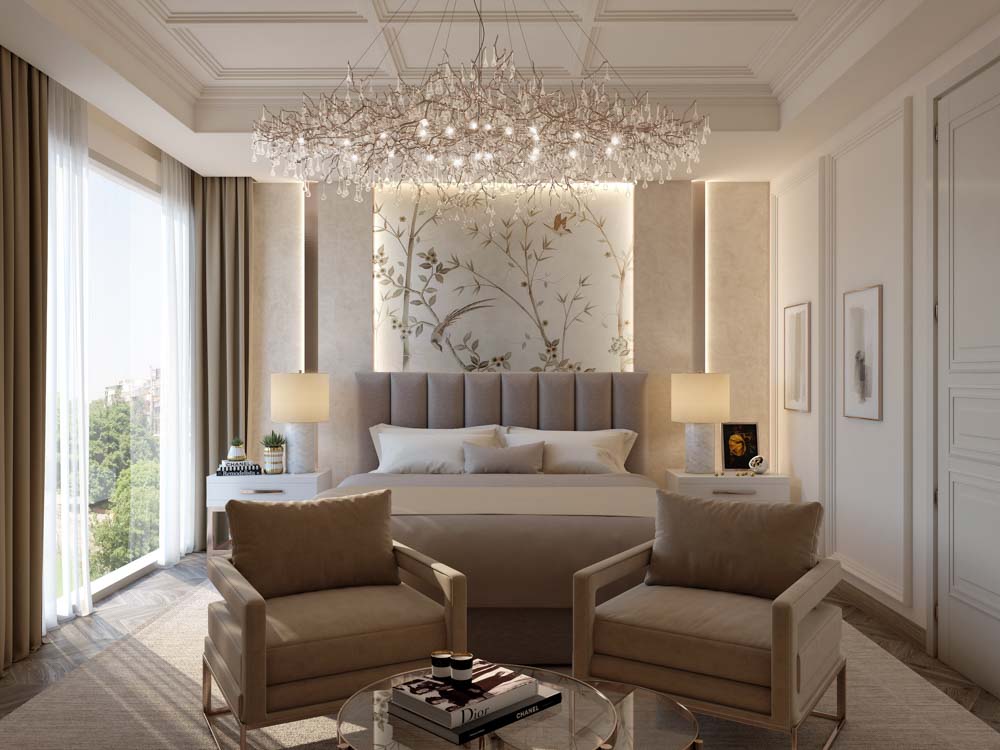
While natural light is important when designing a bedroom, most of us will spend more time in our bedroom when it is dark, so maximizing the potential of artificial bedroom light with a clever bedroom lighting scheme is crucial to creating a cozy and relaxing space and accommodate different activities.
In a bedroom, have a layered approach when thinking about lighting: Mix ambient lighting with task lighting and accent/decorative lighting. This includes a range of overhead, floor, table and wall lights which allow our clients to alter the mood of the space when required.
Soft, diffused light: from dimmable bedside lamps or wall lights, or even a string of fairy lights arranged along your headboard will create a calming aesthetic.
Good task lighting: Provide task lighting for the dressing table to make getting ready easy. Beside the bed, table lamps can provide task lighting for reading if you are avid readers. In a high-ceilinged room, a chandelier or over-sized lampshade will create a focal decorative point.
Ambient lighting: Smart bedroom lighting ideas, such as pendant lights or chandeliers suit rooms with higher ceilings, while flush fixtures will be necessary in those with low ceilings, and all can provide ambient lighting for the room. A floor lamp can look stylish in a seating area, providing illumination for that zone of the room.
Accent lighting: In a room with exposed beams and a vaulted ceiling, LED strips can illuminate it beautifully to show off this feature, and these can also be used as feature lighting above a fixed bed headboard. Lighting can also be incorporated into joinery, such as shelving, to highlight objects on display to make the room more atmospheric.
Dimmer switches: It’s worth choosing light fittings that are compatible with a dimmer switch so you can finely adjust lighting levels to suit the time of day. Think about the placement of light switches as well.
Position switches near the doorway: as well as by the bed, so you don’t have to get up to turn them off and return to bed in darkness.
8. CHOOSE THE BEST COLOUR FOR YOUR BEDROOM

Color plays an important role: in creating an atmosphere in your space. Choosing the best color for your bedroom will ensure that you bring more natural light into the room, and that your color scheme promotes rest and relaxation, rather than overstimulating you before bedtime. And so, painting your bedroom should be one of your first considerations when designing a bedroom and before moving all your furniture in.
Opt for a calm and muted tone: The choice of bedroom paint colors is vast, but consider veering on the side of caution and opting for a calm and muted color palette. To create the illusion of more space, choose a light color scheme.
The best bedroom colors: range from soft whites, grays, or other gentle neutrals, to hues of blue and green. Light greens are a great choice because of their warm undertones, and are super adaptable, calming, and reliably pair with both dark and neutral colors to create the perfect room combo. For small rooms, pale colors that appear to recede from the eye are preferable to visually expand the room. If you want to feel cocooned, dark bedrooms are the way to go.
Create a sophisticated look: Use one single shade or tones of the same color: if you paint walls, skirting, doors, cupboards, radiators and even window frames in the same color, you’ll achieve a thoughtful and modern look. This works particularly well with soft greyed blues and greens as well as any neutral shade. A grey bedroom color scheme is popular as it is soothing and elegant, and a little bit more exciting than white.
Test paint colors under different light conditions before committing: Be aware of the changing light each day in an east or west-facing room, and avoid color choices that will look too cool in the evening for one that’s east facing, or might be overpowering in the evening in a west-facing bedroom.
Choosing items that have delicate or light-colored frames: will avoid overloading the space visually and will make the bedroom feel larger, less formal and brighter, too.
Wallpapers and feature walls: While paint is an easy option, wallpapers and feature walls are also a great way to bring life to your space. Wallpaper is an excellent solution for boring bedroom walls. It adds visual interest, texture, and warmth to any bedroom design, and is a particularly useful trick for making small bedrooms look larger. Choose a wallpaper with a delicate pattern to add dimension, or a bold design to make a statement with your bedroom walls.
9. CHOOSE THE RIGHT BEDROOM FLOORING
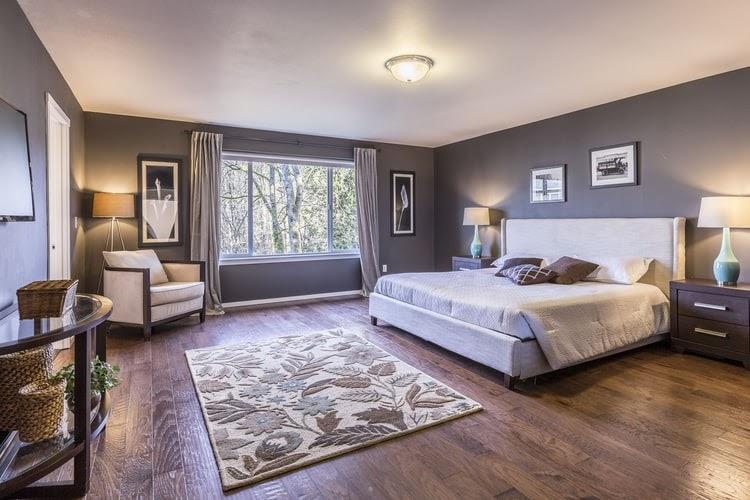
Since you step on to bedroom flooring with bare feet each morning, warmth and comfort are must-have qualities. Commonly used vitrified tiles, marble or granite look cold and feel hard and cold underfoot.
Wooden flooring: Its a good idea to cover the existing tiles with solid hardwood flooring as it gives a warm appearance and brings the beauty of nature to a bedroom. However, solid wood is an expensive option; so consider an engineered wood flooring instead, which will be durable and virtually indistinguishable from solid wood, while being more affordable. If you are on a tight budget, consider laminate flooring or vinyl flooring, with higher quality options replicating the appearance of wood quite convincingly.
Rug or Carpet: Teaming tiled floors or wooden floors with an area rug under the bed is preferable as it provides comfort underfoot when leaving the bed. The look is timeless and elevates the space, too.
10. MAKE YOUR SPACE YOUR OWN WITH PERSONAL DECOR

In any bedroom design, large or small, a few finishing touches can make all the difference. Choosing accessories for the bedroom entirely depends on your tastes and budget: invest in a quality rug and see your bedroom instantly look more elegant; layer cushions and throws to up the comfort factor; create a gallery wall to add interest and color; display photos and pictures to personalize the bedroom; and use house plants to promote a healthy atmosphere. Style your accessories to create an attractive color scheme and a variety of textures. Sheepskin, cotton, and satin do wonder for softening up the look and feel of the space.
This video ‘How to design a functional and cozy bedroom’ summarizes this post:
For more ideas on bedroom furniture and the proper placement of furniture in the room, you can read my posts on:
Related Topics on the designing of a bedroom:
If you found this post useful, all it takes is a simple click on the “pin it” “like,” “share,” “tweet,” or Google+ buttons below the post.




